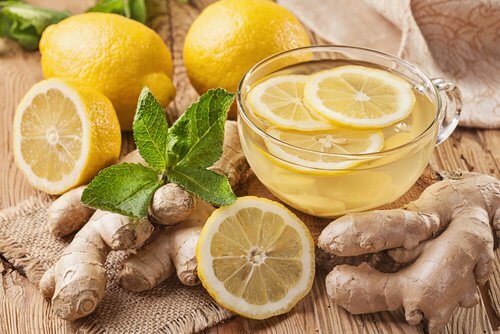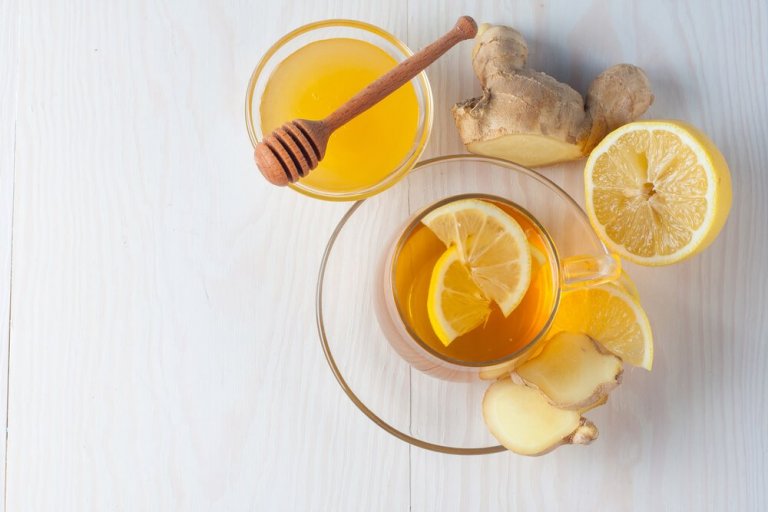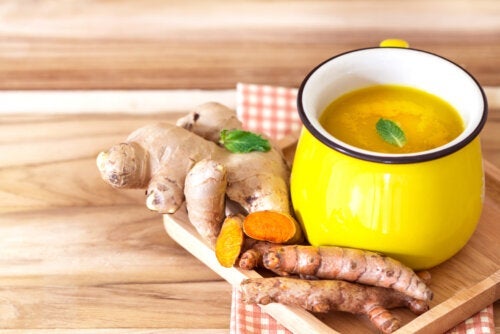레몬 생강차는 집에서 마실 수 있는 건강한 차다. 생강은 생강과에 속하는 식물 뿌리로 음식에 독특한 향과 매운맛을 내는 건강에 좋은 식품이다. 이번 글에서는 레몬 생강차 특성을 알아보자.
레몬 생강차는 소화 불량을 완화하고 면역 체계를 강화하기 위한 가정 요법 목록 1위다. 아래에서 이 차의 이점에 관해 자세히 설명하겠다.
레몬의 장점
레몬은 다양한 요리와 잘 어울리는 매우 다재다능한 과일이다. 이 감귤류는 드레싱이나 요리 재료로 쓰이는 것 외에 여러 건강상 이점이 있다. 우선 활성 산소로부터 신체를 보호하는 데 필수적인 비타민 C가 함유되어 있다.
또한 미국 국립 보건원 간행물에 따르면 비타민 C는 특정 식물성 식품에서 철분 흡수를 개선하고 면역 체계의 적절한 기능에 기여하여 신체를 보호하는 데 이상적이다.
한편, ‘Chemistry Central Journal’에 발표된 리뷰에서는 감귤류의 항염증 성분이 만성 염증성 질환 증상을 완화하는 데 중요한 역할을 한다고 지적한다.

더 읽어보기: 통증을 완화하는 올리브유와 생강
생강의 이점
생강은 풍미뿐만 아니라 영양가 때문에 세계에서 가장 인기 있는 향신료다. 수년 동안 소화를 개선하고 독감 및 감기 증상을 완화하는 데 사용되었다.
이 외에도 ‘Integrative Medicine Insights’ 기사에서는 이 뿌리를 섭취하는 것이 메스꺼움과 구토를 치료하는 효과적이고 자연스러운 방법이라고 한다. 사실, 많은 임신부가 입덧할 때 생강에 많이 의지한다.
또한 4,628명을 대상으로 실시한 ‘영양학 저널’ 연구에서 매일 생강을 섭취하면 심혈관 위험을 예방하는 데 긍정적인 영향을 미칠 수 있다. 동맥 고혈압과 관상 동맥 질환 발병률도 줄일 수 있다.
레몬 생강차 준비 방법
레몬과 생강 이점을 결합하는 가장 좋은 방법은 차를 끓여 마시는 것이다. 이 차는 식물, 허브, 꽃, 과일의 모든 특성을 얻을 수 있으며 준비가 매우 간단하다.
재료
- 껍질을 벗긴 약 2cm의 생강 뿌리 1개
- 물 1컵(200mL)
- 레몬 반 개의 즙
- 꿀(맛보기)
레몬 생강차 준비 방법
- 생강을 조각으로 자른다. 원하면 진한 맛을 위해 갈아서 쓸 수 있다.
- 그런 다음 작은 냄비에 물을 데우고 생강과 레몬즙을 넣는다.
- 물이 끓기 전에 어느 정도 뜨거워지면 불을 끄고 5~10분 동안 그대로 둔다.
- 생강을 걸러낸 차를 레몬 조각과 함께 뜨겁게 제공하자. 원하는 경우 꿀로 단맛을 낸다.
- 하루에 3번까지 마실 수 있다.
레몬 생강차를 마시면 좋은 때
언제든지 즐길 수 있지만 증상을 완화하거나 추가 에너지를 얻고자 하는 경우 권장되는 몇 가지 상황이 있다.
신진대사를 촉진하고 체지방 감소에 기여하려면 아침에 마시는 것이 이상적이다. 또한 식사 전에 마시면 소화를 촉진한다.
식사 후에 마시면 가스 축적을 방지한다. 마지막으로 숙면하고 싶다면 밤에 자기 전에 마신다.

더 읽어보기: 소화 불량을 완화하는 5가지 자연 요법
레몬 생강차 부작용
앞서 언급한 바와 같이 레몬 생강차를 적당량 마시는 것은 안전하지만 생강의 과도한 사용은 위 역류를 악화할 수 있다. 또한 너무 많이 마시면 입과 목에 자극을 준다.
따라서 너무 많이 마시지 않도록 한다. 레몬 생강차는 경미한 증상을 지원만 하며 기적의 치료제가 아니다. 궁금한 점이 있으면 의사와 상담하자.
참고 문헌
모든 인용된 출처는 품질, 신뢰성, 관련성 및 유효성을 보장하기 위해 저희 팀이 철저히 검토했습니다. 이 글의 참고 문헌은 신뢰할 수 있으며 학문적 또는 과학적 정확성을 갖춘 것으로 간주되었습니다.
- Al-Ataby, I. A., & Talib, W. H. (2022). Daily consumption of lemon and ginger herbal infusion caused tumor regression and activation of the immune system in a mouse model of breast cancer. Frontiers in Nutrition. 9, 1-12. https://www.ncbi.nlm.nih.gov/pmc/articles/PMC9043650/
- Bodagh, M. N., Maleki, I., & Hekmatdoost, A. (2019). Ginger and gastrointestinal disorders: a systematic review of clinical trials. Food Science and Nutrition, 7(1), 96-108. https://www.ncbi.nlm.nih.gov/pmc/articles/PMC6341159/
- Carr, A. C., Maggini, S. (2017). Vitamin C and immune function. Nutrients, 9(11), 1-25. https://www.ncbi.nlm.nih.gov/pmc/articles/PMC5707683/
- Federación Española de la Nutrición (FEN). (s.f). Limón. Consultado el 23 de febrero de 2023. https://www.fen.org.es/MercadoAlimentosFEN/pdfs/limon.pdf
- Khodaie, L., & Sadeghpoor O. (2015). Ginger: from ancient times to new outlook. Jundishapur Journal of Natural Pharmaceutical Products, 10(1), 1-5. https://www.ncbi.nlm.nih.gov/pmc/articles/PMC4377061/
- Klimek-Szczykutowicz, M., Szopa, A. & Ekiert, H. (2020). Citrus limon (Lemon) phenomenon. A review of the chemistry, pharmacological properties, applications in the modern pharmaceutical, food and cosmetics industries and biotechnological studies. Plants, 9(1), 1-24. https://www.ncbi.nlm.nih.gov/pmc/articles/PMC7020168/
- Maharlouei, M., Tabirzi, R., Lankarani, K. B., Razaianzadeh, A., Akbari, M., Kolahdooz, F., Rahimi, M., Kaneshlou, F., & Asemi, Z. (2019). The effects of ginger intake on weight loss and metabolic profiles among overweight and obese subjects: a systematic review and meta-analysis of randomized controlled-trials. Critical Reviews in Food Science and Nutrition, 59(11), 1753-1766. https://pubmed.ncbi.nlm.nih.gov/29393665/
- Mahmoud, A. M., Hernandez Bautista, R. J., Sandhu, M. A., & Hussein, O. E. (2019). Beneficial effects of citrus flavonoids on cardiovascular and metabolic health. Oxidative Medicine and Cellular Longevity, 1-19. https://www.ncbi.nlm.nih.gov/pmc/articles/PMC6431442/
- Mansour, M. S., Ni, Y-M., Roberts, A. L., Kelleman, M., Roychoudhury, A., & St-Onge, M. P. (2012). Ginger consumption enhances the thermic effect of food and promotes feelings of satiety without affecting metabolic parameters in overweight men: A pilot study. Metabolism, 61(10), 1347-1352. https://pubmed.ncbi.nlm.nih.gov/22538118/
- Marchan, A., & Elizabeth, Lady. (2022). Consumo alimentario de hierro y vitamina C en gestantes anémicas atendidas en el centro de salud Zorritos, Tumbes 2022. [Tesis de pregrado, Universidad Nacional de Tumbes]. Archivo digital. http://repositorio.untumbes.edu.pe/handle/20.500.12874/63912
- Modi, M., & Modi, K. (28 de nviembre de 2022). Ginger Root. StatPearls Publishing. Consultado el 23 de febrero de 2023. https://www.ncbi.nlm.nih.gov/books/NBK565886/
- Mount Sinai. (s.f.). Ginger. Consultado el 23 de febrero de 2023. https://www.mountsinai.org/health-library/herb/ginger
- Mustafa, I., Chin, N. L. (2023). Antioxidant properties of dried ginger (Zingiber officinale Roscoe) var. Bentong. Foods, 12(1), 1-18. https://www.mdpi.com/2304-8158/12/1/178
- National Institutes of Health. (18 de diciembre de 2019). Office of Dietary Supplements. (2019). Vitamina C. Consultado el 23 de febrero de 2023. https://ods.od.nih.gov/factsheets/VitaminC-DatosEnEspanol/
- Pizzino, G., Irrera, N., Cucinotta, M., Pallio, G., Mannina, F., Arcoraci, V., Squadrito, F., Altavilla, D., & Bitto, A. (2017). Oxidative stress: harms and benefits for human health. Oxidative Medicine and Cellular Longevity. 2017, 1-13. https://www.ncbi.nlm.nih.gov/pmc/articles/PMC5551541/
- Siedentopp, U. (2008). El jengibre, una planta medicinal eficaz como medicamento, especia o infusión. Revista Internacional de Acupuntura. 2 (3): 188-192. https://www.elsevier.es/es-revista-revista-internacional-acupuntura-279-articulo-el-jengibre-una-planta-medicinal-13125914
- Wang, Y., Yu, H., Zhang, X., Feng, Q., Guo, X., Li, S., Li, R., Chu, D., & Ma, Y. (2017). Evaluation of daily ginger consumption for the prevention of chronic diseases in adults: A cross-sectional study. Nutrition. 36, 79-84. https://www.sciencedirect.com/science/article/abs/pii/S089990071630082X?via%3Dihub

